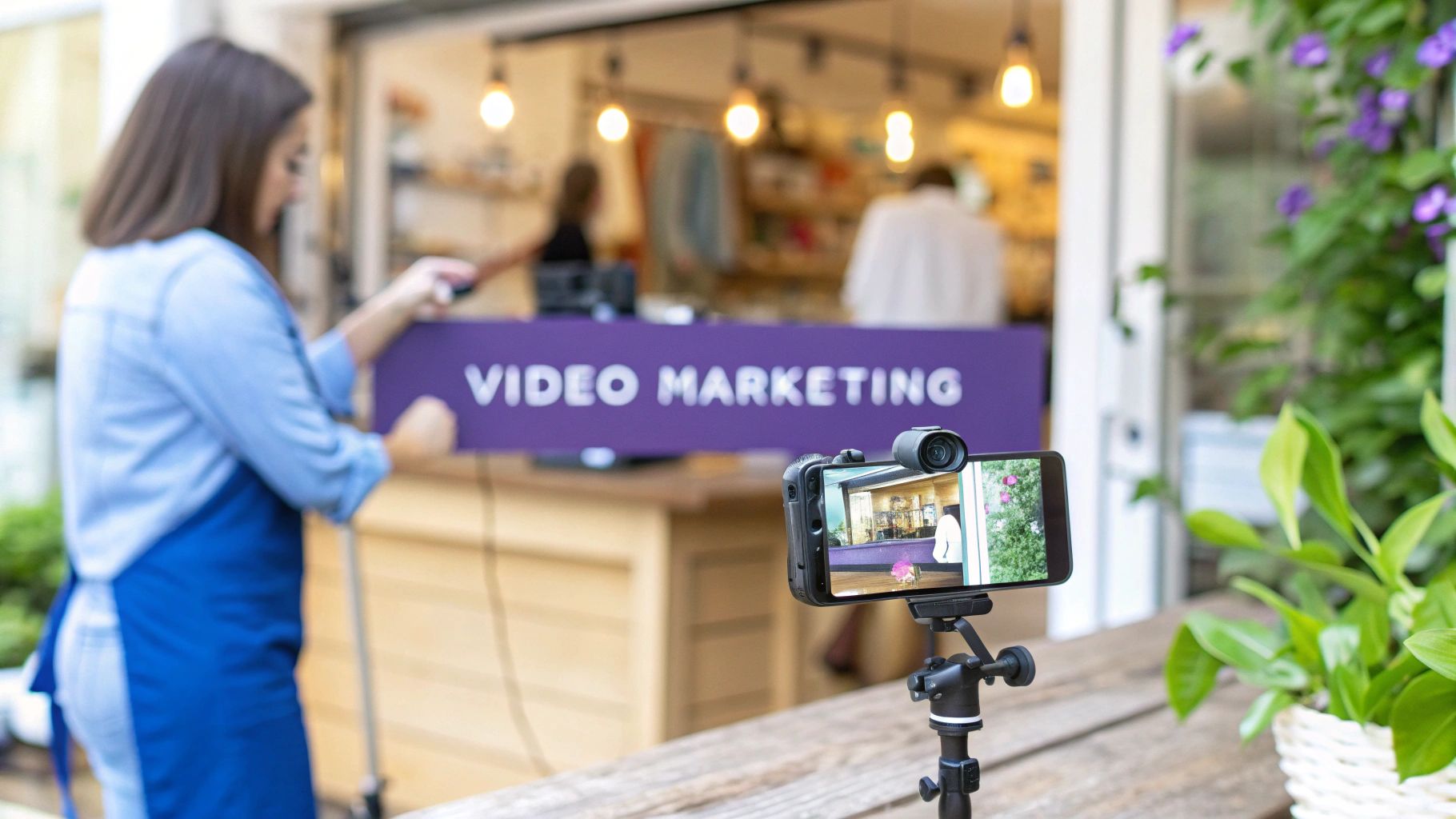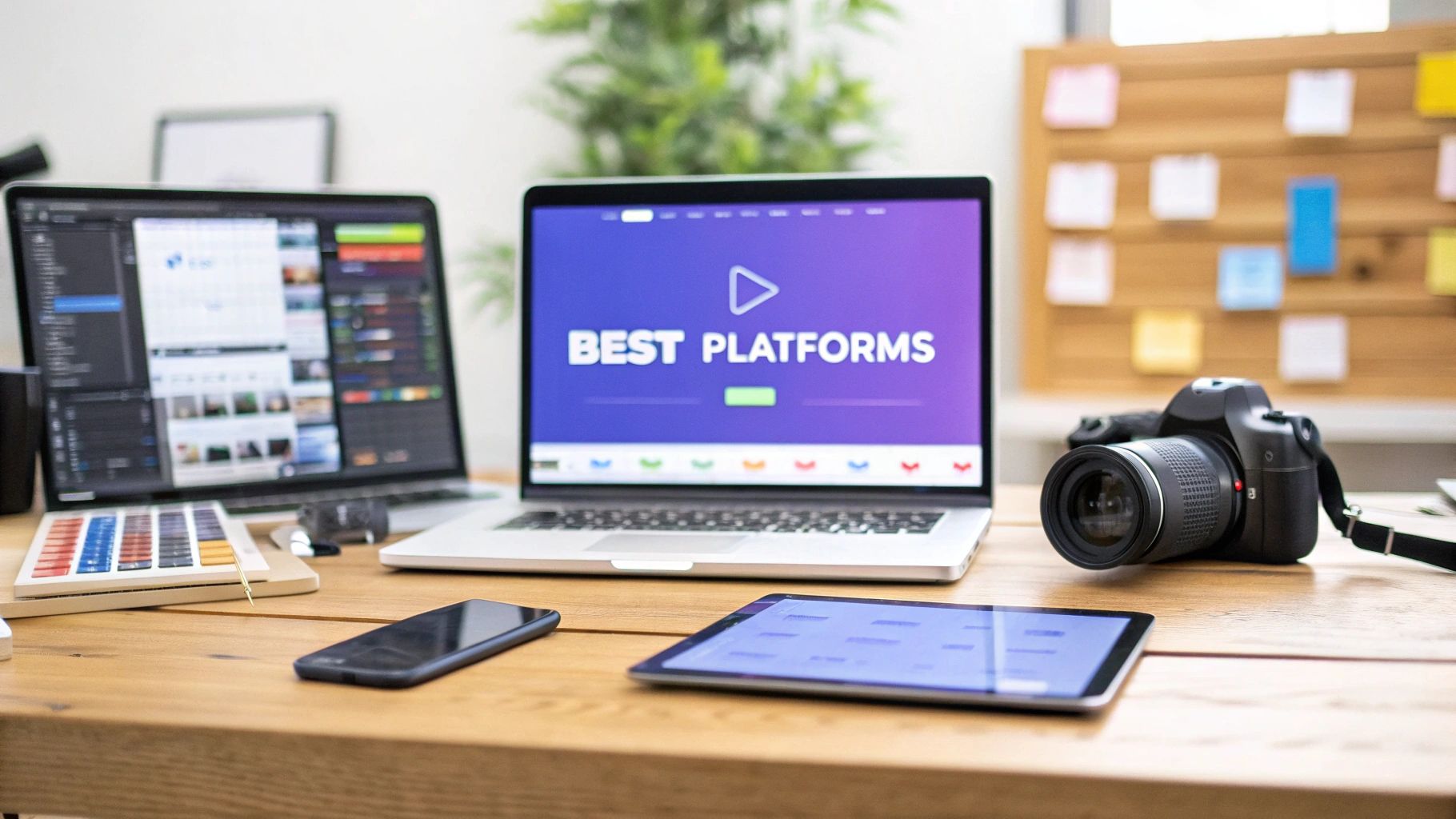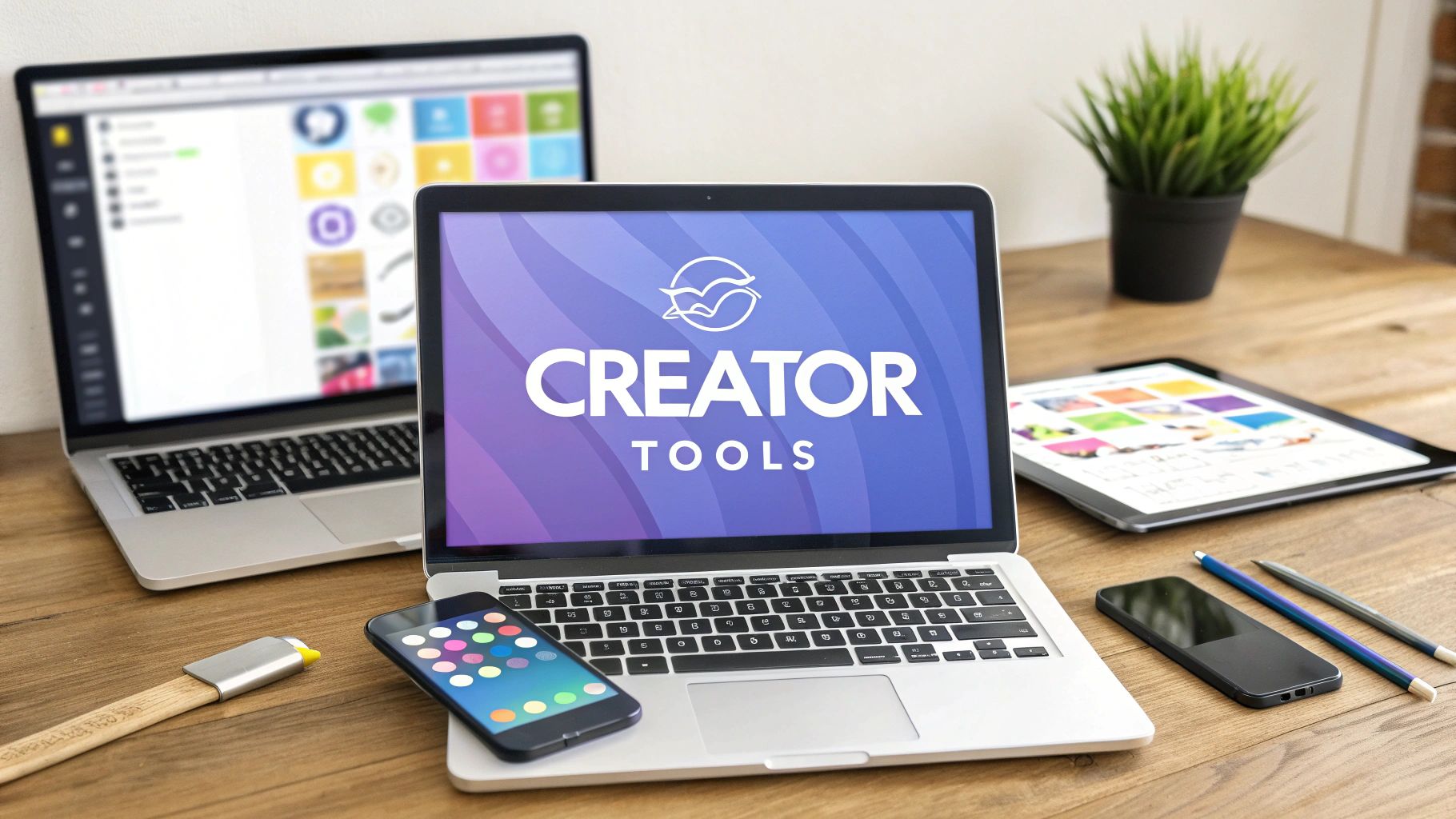Why Small Business Video Marketing Changes Everything

Imagine Sarah, a local bakery owner. Before sunrise one morning, she filmed a short, 30-second video of herself decorating cupcakes. Nothing fancy, just a simple clip showcasing her passion. That video generated more customer inquiries in a single week than six months of regular social media posts. Sarah's story isn't unique; it perfectly illustrates the power of small business video marketing.
Think about your own online habits. Are you more likely to read a long block of text, or stop to watch an interesting video? Most of us would choose the video. This preference reflects a larger shift: consumers value authenticity. They connect with real moments and relatable stories, not polished, impersonal ads. Video offers a glimpse behind the scenes of your business, letting you share your personality, values, and passion. This builds trust, which is essential for turning potential customers into loyal ones.
In today's information overload, it's hard to grab attention. Video, with its dynamic blend of visuals, sound, and movement, is inherently more engaging than static content. This helps small businesses make a memorable impact, even on a tight budget. A quick video demonstrating a new product feature, for example, can be much more effective than a long blog post or several still images. This makes video marketing not just a good idea, but a must-have for staying competitive.
Creating videos is easier than ever. High-quality smartphone cameras, easy-to-use editing software like Adobe Premiere Pro or DaVinci Resolve, and even AI-powered video platforms like Pictory AI are readily available. This means even small businesses can create professional-looking videos. They can experiment with different video styles, tell compelling stories, and connect with their audience in exciting new ways.
In fact, as of 2025, 55% of small businesses incorporate video marketing into their strategies, while 89% of all businesses use video in some capacity. Discover more insights about video marketing trends here. This shows that businesses, especially smaller ones, recognize the power of video. It's time to make video a core part of your long-term marketing plan, not just a passing fad.
Decoding The Video Marketing Landscape For Small Business
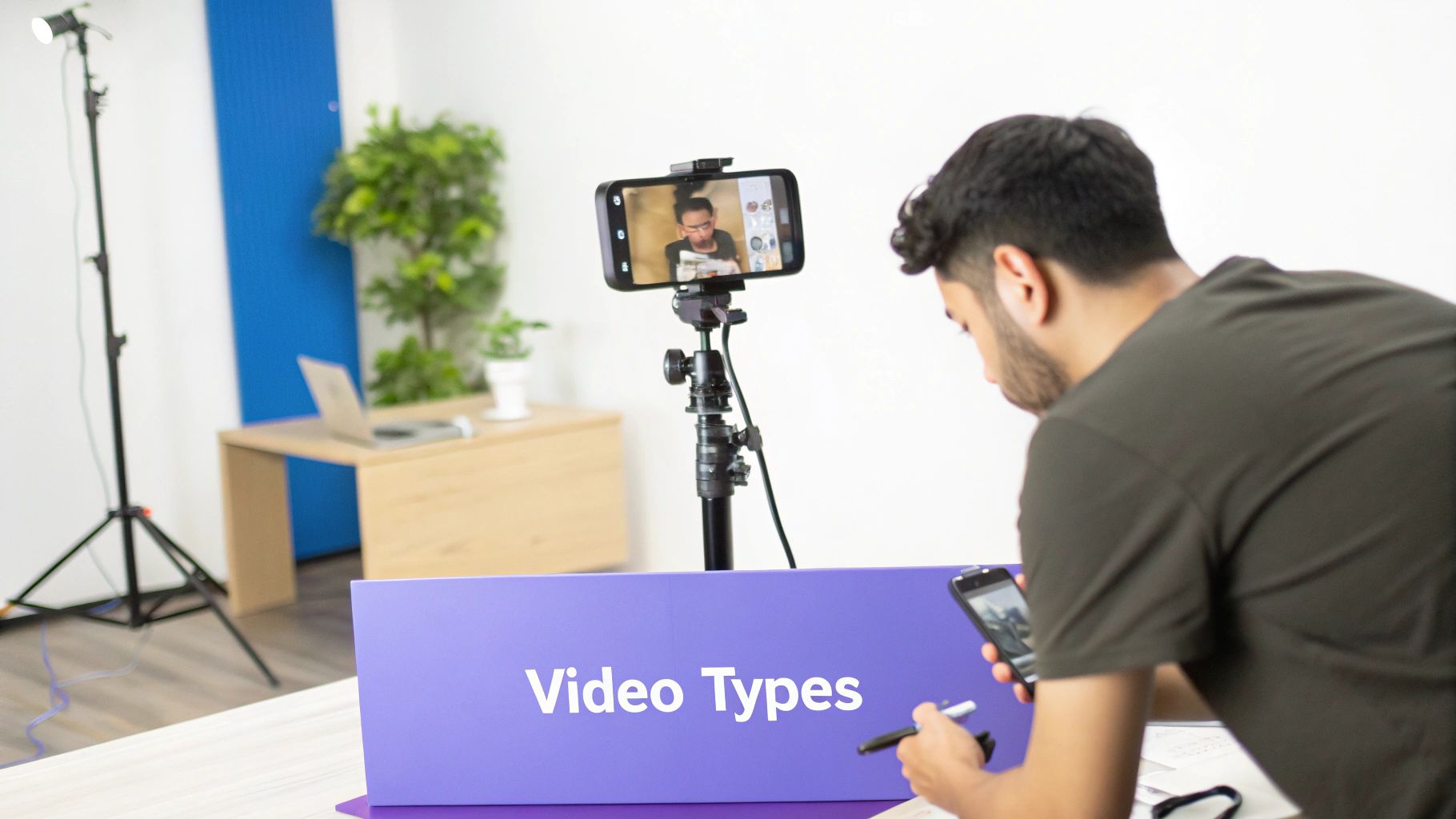
Think of video marketing for your small business like setting up a well-stocked kitchen. Each type of video has its own special purpose, just like the different tools you’d use to create a meal. You wouldn't use a whisk to flip a steak, and similarly, a testimonial video wouldn’t be the best choice for explaining how your product works.
Matching Video Types to Business Goals
Knowing what you want to achieve is the first ingredient in a successful video marketing recipe. Are you trying to get your name out there, boost sales, or teach your audience something new? Different video formats are better suited for different goals.
For instance, if you're hoping to make your brand feel more personal, behind-the-scenes videos are a great option. They give your audience a peek into your company culture and the people who make your business tick. This builds trust and creates a stronger connection.
Another powerful way to connect with your audience is through educational videos. By sharing valuable information related to your industry, you establish yourself as an expert and attract potential customers looking for solutions. This builds credibility and trust.
But what if your main goal is to increase sales? Product demonstration videos are your secret weapon. These videos show your product in action, highlighting its features and benefits, and convincing potential customers of its value. It's like letting them try before they buy.
Leveraging Testimonials and Social Proof
Don’t forget the power of word-of-mouth. Customer testimonial videos feature happy customers sharing their positive experiences. This type of social proof is often much more convincing than traditional advertising because people trust the opinions of others.
Think about where your customers are in their buying journey. Behind-the-scenes content is great for engaging existing followers and building brand loyalty. Product demos, however, are better for targeting potential customers who are closer to making a purchase. By tailoring your video content to the specific needs and interests of your audience at each stage, you create a more effective video marketing strategy.
Choosing Platforms That Actually Deliver Results
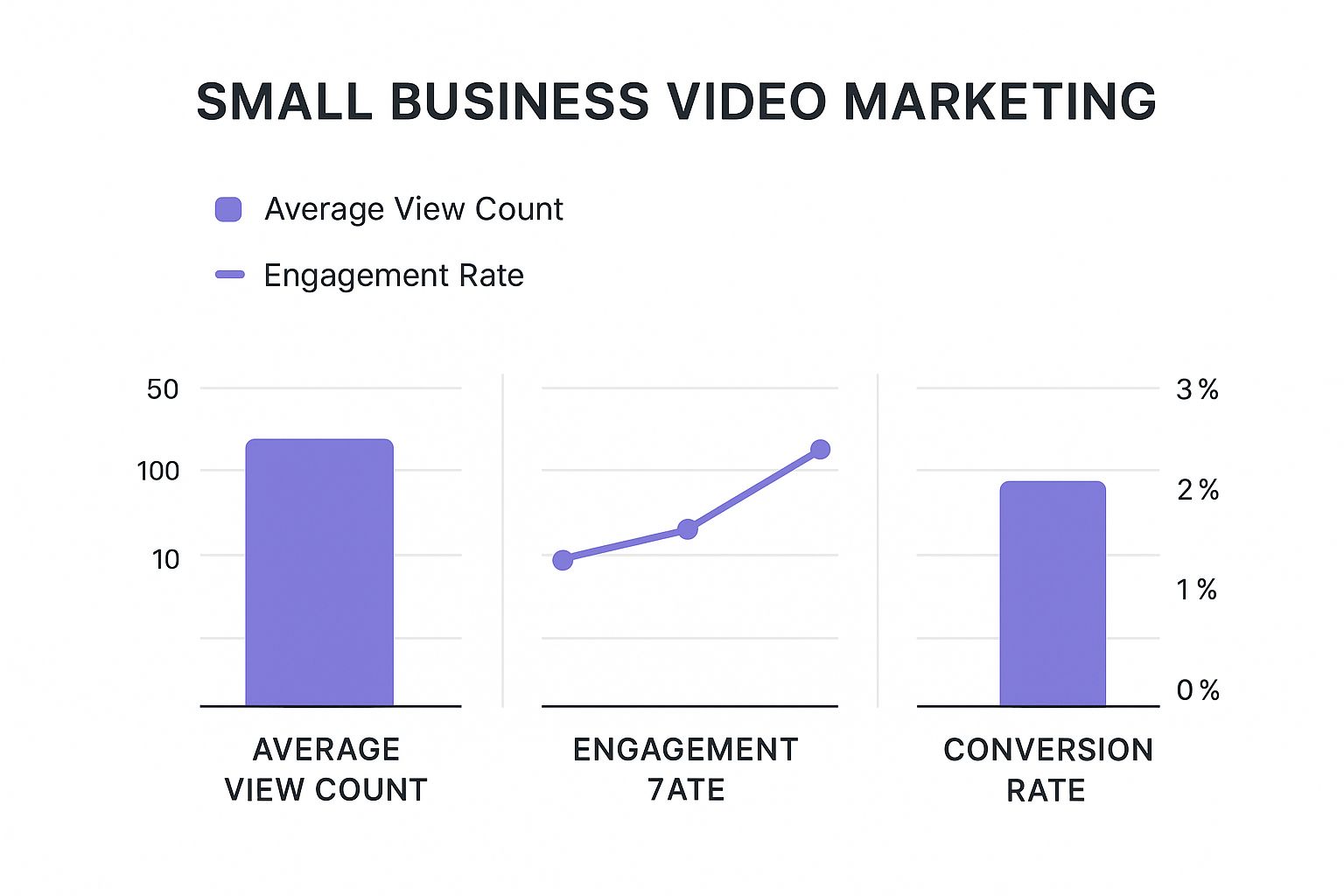
The infographic above gives us a snapshot of key metrics for small business video marketing. It shows average view counts, engagement rates, and conversion rates. While those view counts can look impressive, engagement and conversion often tell a different story. This really highlights why choosing the right platforms is so important. It's not about being on every single platform, but rather focusing your energy where it matters most. Spreading yourself too thin just dilutes your impact.
Think of it like gardening. You wouldn't scatter seeds randomly and expect a bountiful harvest. You'd choose the best soil, the right amount of sunlight, and nurture specific plants. Similarly, you need to understand the nuances of each platform and how your audience behaves there. Matching your content strategy to the platform's strengths and your audience's preferences is crucial for success. For a more in-depth look at video distribution, check out our guide on video distribution platforms.
Understanding Platform Strengths
Let's break down a few examples. YouTube thrives on search. It’s like the Google of video content. Creating optimized, evergreen content on YouTube builds long-term discoverability. This means your videos can still attract viewers months after you’ve published them, simply because people are searching for related topics.
TikTok works differently. It's driven by an engagement-based algorithm. Short, engaging videos that get people liking, sharing, and commenting are rewarded with more visibility. TikTok is great for quickly building an audience and capitalizing on trends.
Now consider LinkedIn. This is where B2B businesses shine. Its professional focus makes it ideal for sharing insightful content and connecting with potential clients. Contrast this with Instagram, where visual storytelling and behind-the-scenes content thrive. Instagram Stories are especially useful for showing your brand's personality and engaging with your audience casually.
Short-form video is a game-changer, offering cost-effective solutions for small businesses. It actually delivers the highest return on investment (ROI) compared to other marketing trends. Remember, optimal video length depends on the platform: under 15 seconds for Instagram and X (formerly Twitter), 15–60 seconds for TikTok, and over 60 seconds for YouTube. Learn more about social media video statistics.
To help you visualize this, let’s take a look at the following table:
Platform-Specific Video Length and Format Optimization
| Platform | Optimal Length | Best Content Type | Primary Audience | Key Feature |
|---|---|---|---|---|
| YouTube | 60+ seconds | Evergreen, tutorial, in-depth | Broad audience, niche interests | Search discoverability |
| TikTok | 15-60 seconds | Short, engaging, trending | Gen Z, millennials | Viral potential |
| Under 15 seconds | Visually appealing, behind-the-scenes | Millennials, Gen Z | Stories, Reels | |
| X (formerly Twitter) | Under 15 seconds | News, updates, quick tips | Broad audience | Real-time engagement |
| Varies, but generally shorter | Professional insights, thought leadership | Business professionals | B2B connections |
This table summarizes the sweet spot for each platform, highlighting how video length, content style, and target audience all play a role.
Choosing Your Battles Wisely
Picking the right platforms is about knowing your audience and your resources. Creating content for multiple platforms can be overwhelming, especially if you have a small team.
Instead of trying to be everywhere at once, think about dominating one platform first. Become an expert on that platform, build a loyal following, and learn the ins and outs of its algorithm. Once you’ve nailed that, you can expand your efforts, using what you’ve learned and the resources you’ve gained. This focused approach gives you the best chance for success in the competitive world of small business video marketing.
Creating Compelling Content Without Hollywood Budgets
Jake, a small auto repair shop owner, never imagined he'd be a video marketing success story. His winning video? A simple smartphone clip, filmed under the shop lights, explaining why a customer's brake pads needed replacing. This authentic, educational approach generated more leads than any pricey radio spot. Jake’s story proves a point: compelling small business video marketing isn't about big budgets. It's about genuine connection.
The Psychology of Engagement
Why did Jake's simple video work so well? It tapped into the core of what grabs attention. Viewers value authenticity. They connect with real people sharing real stories. That’s why polished, corporate videos often miss the mark. They lack the human touch that builds trust. Think about it: would you trust a friend's suggestion or a slick commercial more?
Storytelling Frameworks That Stick
Turning everyday business moments into engaging videos is easier than you might think. Here’s a straightforward framework:
- The Hook: The first three seconds are everything. Grab attention instantly with a question, a surprising fact, or a striking visual. Think of it like a fishing lure – it needs to be irresistible.
- The Build-Up: Create a little tension. Present a problem, highlight a challenge, or show a need. This keeps viewers hooked and curious about the solution. Just like a good story, you need to build anticipation.
- The Resolution: Provide a satisfying payoff. Offer the solution, reveal the result, or give useful information. This leaves viewers feeling satisfied and ready to take action. It's not just about entertainment, it's about results.
Content Calendars: Consistency Without Overwhelm
A content calendar helps maintain consistent posting without burnout. Start small, maybe one video a week. Plan content around events, promotions, or common customer questions. Batch filming several videos at once to save time. For example, a baker could film videos about various holiday treats in a single afternoon. You might be interested in: how to create AI video ads.
Turning Routine into Compelling Content
Consider your daily work. What unique aspects of your business can you share? A florist could create a time-lapse of arranging a bouquet. A coffee shop owner could film a short tutorial on brewing the perfect cup at home. These seemingly ordinary moments, when presented authentically, can be surprisingly engaging. Remember Jake’s brake pad video? A routine repair turned into compelling content.
Real Examples: From Ordinary to Extraordinary
A bookstore owner created videos recommending her favorite books each month. A local gym owner films quick workout tips with minimal equipment. These examples show how small businesses can create extraordinary content from everyday moments. Focus on providing value, showcasing your expertise, and connecting authentically. This builds trust and fosters long-term customer relationships that lead to real business growth.
Harnessing AI Tools To Scale Your Video Production
Imagine having a tireless video production assistant who never clocks out. That's the power of AI-powered video marketing tools for small businesses. These tools are leveling the playing field, making professional-quality video production accessible even on a tight budget.
AI-Powered Efficiency
One of the biggest challenges small businesses face with video is the time and cost involved. AI tools offer a solution by automating key parts of the process. AI-generated scripts, for example, can help you quickly develop engaging narratives. Think of it like having a dedicated scriptwriter working 24/7. Automated editing tools can then transform your raw footage into polished videos, saving you hours of manual editing work. This means you can create more videos, more consistently, without a big production team.
From Idea to Finished Product
AI can streamline your entire video creation workflow, from brainstorming to distribution. Some platforms offer AI-powered storyboarding, allowing you to visualize your video before you even pick up a camera. Others provide automated music selection and sound effects, eliminating the hassle of licensing fees and audio editing. This frees you to focus on the creative side of video marketing—telling your story and connecting with your audience.
Choosing the Right AI Tools
While the potential of AI is huge, it's important to choose the right tools for your needs. Some AI tools might have flashy features that don't actually improve your videos. Look for tools that offer practical benefits like enhanced video and audio quality, and automation of tedious tasks. For example, AI-powered transcription and captioning can make your videos accessible to a wider audience and boost your SEO.
To help you navigate the options, take a look at this comparison table:
AI Video Marketing Tools Comparison for Small Businesses Overview of popular AI-powered video creation and editing tools, their features, pricing, and best use cases for small business video marketing
| Tool Name | Primary Function | Pricing Range | Best For | Key Benefits |
|---|---|---|---|---|
| Pictory AI | AI-powered video generation from blog posts and other text content | Starts at $19/month | Creating quick explainer videos and social media content | Automated video creation, various templates, easy to use |
| Synthesia | AI-powered video generation with realistic avatars | Starts at $30/month | Creating professional-looking videos with diverse presenters | Realistic avatars, multiple languages, various video formats |
| Descript | AI-powered audio and video editing and transcription | Starts at $12/month | Editing videos and podcasts, creating transcriptions and captions | Easy editing interface, powerful transcription features, collaboration tools |
| Steve.AI | AI-powered video creation with animated characters | Starts at $20/month | Creating engaging animated videos for marketing and education | Customizable characters, various animation styles, easy to use |
| In-Vid | AI-powered interactive video platform | Custom pricing | Creating interactive videos for marketing and e-commerce | Interactive elements, personalized video experiences, data analytics |
This table gives you a quick overview of some popular AI video tools. Remember to research and compare options to find the best fit for your business.
The growing adoption of AI in video marketing underscores its importance. In 2023, only 18% of marketers used AI for video. By 2024, that number jumped to 41%. Now, more than half (51%) of video marketers use AI tools for content creation or editing. Discover more insights about video marketing and AI adoption here.
Maintaining Authenticity
Some small businesses worry that using AI will make their videos feel generic. However, AI should enhance, not replace, your creative vision. The goal is to use AI to streamline production, so you can focus on creating authentic content that reflects your brand. By combining AI-powered efficiency with your unique voice, you can scale video production without losing what makes you special.
Realistic Expectations and Limitations
While AI can be a game-changer, it's important to have realistic expectations. AI tools aren’t a magic solution; they can't replace human creativity and strategy. Understanding AI’s current limitations is key. For example, AI-generated scripts often need editing to ensure they accurately reflect your brand’s tone. Automated editing tools might not always make the perfect creative choices, requiring some manual adjustments. By recognizing both the power and the limits of AI, you can effectively use these tools to create impactful video marketing campaigns.
Building Systems That Sustain Long-Term Success

That viral video feeling is great, right? But let's be real, lasting success with video marketing for your small business isn't about one-hit wonders. It's about building a system that consistently delivers. Think of it like a bustling restaurant kitchen during the dinner rush. Every ingredient, process, and team member must work together seamlessly to serve up quality dishes under pressure. Your video marketing needs that same well-oiled machine behind it.
Content Planning: The Recipe For Success
Just as a chef meticulously plans their menu, you need a content plan for your videos. This starts with truly understanding your target audience, defining your video goals, and brainstorming ideas that hit the mark with both. Think of your content calendar as the week's menu, outlining which videos you'll create and when they'll go live. This keeps your content flowing and your audience engaged.
For example, imagine a florist. Their content calendar could feature Mother's Day bouquets in April, graduation arrangements in May, and summer wedding centerpieces in June. Planning ahead ensures your content is always in season and relevant to your audience.
Production: Streamlining Your Kitchen
In a busy kitchen, efficiency is key. Batching your video creation is a smart move. Just like a chef preps ingredients before the rush, you can film multiple videos in a single session. This saves valuable time and keeps a consistent look and feel across your content.
Templates are another efficiency booster. Think of them as standardized recipes for your videos. Set templates for your intro/outro sequences, brand colors, and fonts. This saves design time while keeping your branding consistent across all your videos.
Distribution: Serving Your Content
Where you share your videos matters just as much as the content itself. Are your customers hanging out on YouTube, TikTok, or Instagram? Choosing the right platforms maximizes your reach. It's like a restaurant choosing the right dishes for its menu based on its location and target clientele.
Delegation and Automation: Empowering Your Team
Just as a head chef delegates tasks, you can bring others into your video marketing efforts. Assign roles like scriptwriting, filming, or social media promotion to team members. Clearly defined roles keep things running smoothly and prevent bottlenecks.
Automation tools can handle routine tasks like scheduling posts, generating captions, or even transcribing videos. This frees you up to focus on the bigger picture – strategy and creative development. Think of these tools as automated kitchen appliances that streamline food prep, allowing chefs to concentrate on crafting delicious dishes.
Troubleshooting and Scaling: Adapting To Growth
Even the best-laid plans encounter hiccups. Common bottlenecks include production delays, inconsistent posting, or trouble tracking results. Having a plan to tackle these challenges is crucial for staying on track. It’s like having a backup generator for your restaurant – ensuring service continues even during a power outage.
As your business grows, so should your video marketing strategy. Start small, refine your system, and gradually increase your output. Like a successful restaurant adding more tables or opening new locations, your video marketing can scale to reach a wider audience and achieve bigger goals. By building a strong foundation and adapting to change, you can create a video marketing system that drives long-term growth and success.
Measuring What Matters And Optimizing For Growth
Vanity metrics can be alluring. A million views sounds impressive, doesn't it? But what if those views don't translate into actual business results? They become just that: empty numbers. For small businesses, video marketing success isn't about going viral. It's about making connections with the right audience and guiding those viewers toward becoming customers.
Beyond Vanity: Metrics That Matter
Which metrics do matter? Engagement is key. Think of a view as someone window-shopping. Engagement—likes, comments, shares—is like that person walking into the store, browsing, and asking questions. High engagement reveals genuine interest and starts to build a community around your brand.
Conversion tracking takes this a step further. It measures how many viewers take a specific action, whether visiting your website, subscribing to a newsletter, or purchasing something. This directly links video marketing efforts to business outcomes, showcasing a tangible return on investment. For a more in-depth look at incorporating AI into your video marketing strategies, check out our guide Boost Your Business With AI Marketing Video Strategies.
Actionable Insights, Not Data Overload
Setting up the right analytics is crucial. It’s not about having mountains of data; it’s about gleaning actionable insights. Think of a chef tasting their dish throughout the cooking process, not just at the end. Regularly checking metrics allows for adjustments to your video strategy, ensuring your content consistently resonates with your audience.
Testing, Refining, and Iterating
A/B testing is a powerful optimization tool. Create two slightly different video versions—perhaps with varied titles or calls to action—and track their performance. It's like a taste test, letting your audience tell you what they prefer. Use feedback, comments, and engagement patterns to understand why one version works better. This data-driven approach removes the guesswork and allows you to continuously improve.
Real-World Applications: Small Business Success
Imagine a small bakery making videos about their cakes. By tracking watch time, they notice viewers often stop watching during the frosting demonstration. They respond by creating shorter, more focused frosting tutorials, increasing engagement and website traffic.
Another example: a local bookstore A/B tests two book review videos. One features the owner, the other an employee. The owner's video gets significantly more engagement, suggesting customers value a personal touch. This discovery shapes their future video strategy.
Connecting Video to Business Outcomes
Ultimately, small business video marketing success hinges on its impact on your bottom line. Establish clear frameworks connecting video performance to business results. Track how many leads are generated, sales are made, or how customer lifetime value increases because of your videos. This demonstrates the value of your efforts and justifies the investment. Picture a small business experiencing a 20% increase in sales directly after launching a new video series. That's concrete evidence of effective video marketing.
By focusing on relevant metrics and continually refining your strategy based on data, you can transform your small business video marketing from an experiment into a powerful growth engine.
Ready to transform your video marketing strategy? Sprello, an AI-powered video creation platform, helps businesses create high-performing user-generated content (UGC) style ads quickly and easily. Visit Sprello to learn more and start your free trial today!
